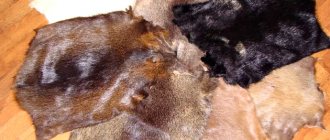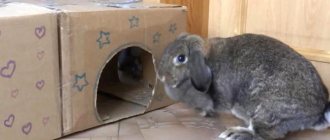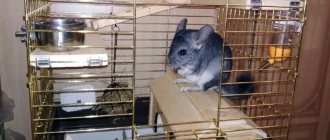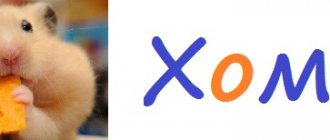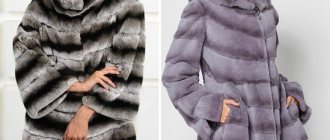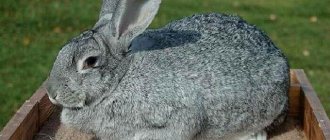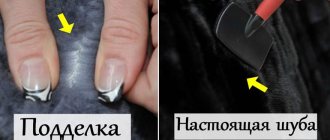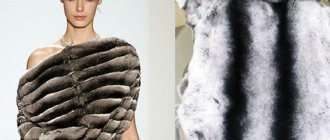How to distinguish chinchilla fur from rex fur?
In the 21st century, world designers delight the fair sex with a huge selection of fur products. Fashionable fur boutiques, salons and shops amaze with the abundance of products, various styles, models, sizes and colors. Every fashionista can easily choose and buy a fur product to her liking. In order not to make a mistake in choosing, it is necessary to distinguish between furs and know the differences between one fur and another.
A fur coat or vest made of chinchilla fur is the cherished dream of all fashionistas. Each of us would not refuse to buy a chinchilla fur coat. Now the chinchilla fur coat is at the peak of popularity. But still, not all ladies decide to buy this product. First of all, because of the high price, because this fur is one of the top three most expensive furs. So if you want to buy a chinchilla fur coat, then treat your purchase with extreme caution. After all, very often you can be deceived and buy a fake. There is a specially bred breed of short-haired rabbits, whose fur is quite close in its characteristics and properties to chinchilla fur. We're talking about the Rex rabbit.
Rex rabbit fur is soft and dense, retains heat perfectly. This breed appeared in France in 1919. Rex fur is very pleasant to the touch, thick, due to the lack of tiers, it looks perfectly smooth and trimmed, the height of the fur is approximately 2 cm. The dense pile grows vertically and thanks to this the fur does not wrinkle. A Rex fur coat looks like velvet, it retains heat well and has good wear resistance properties. In appearance, the fur is very similar to chinchilla fur and is visually practically indistinguishable.
With the development of modern technologies and selection, sometimes it is not clear which animal’s fur is in front of you. Some tips on how to distinguish chinchilla fur from rex rabbit fur:
- First of all, this is the cost of the product. The price of chinchilla fur is very high, and is one of the three most expensive furs in the world. Prices for chinchilla fur products do not go down even during the biggest sales. Therefore, if you are offered a chinchilla with a 70% discount, rest assured that this is a Rex rabbit.
- Pay your attention to the structure of the fur. In a chinchilla, an average of 50 fine hairs grow from one hair follicle. This unique structure of the fur makes it very thick and no other fur can compare with it in this property. Chinchilla fur is softer, airier and thicker, Rex fur is rougher to the touch.
- The chinchilla is a small animal. Therefore, the length of its skin reaches a maximum of 30-35 cm, and its width is no more than the width of the palm. The rabbit is larger, so the edges of the skins will be slightly different. The length of the pile on a chinchilla's back and stomach is different. The light areas of the fur will be shorter than the dark ones, because of this the product will acquire a certain waviness.
- The natural color of a chinchilla is dark gray with a white or white-bluish belly. Along the entire length, the color is heterogeneous. Animals with a different color have also been bred, so do not be surprised by a fur coat in brown and beige tones. Chinchilla fur is very rarely dyed, as it is too expensive for this procedure.
- The chinchilla's undercoat is the same length as the covering hairs. Hard guard hairs are completely absent. Because of this, the fur is very delicate.
- The flesh of a rabbit is heavier and denser than that of a chinchilla. The weight of the products will vary accordingly. Try weighing the product in your hands. The chinchilla fur product is very light.
- While chinchilla fur usually feels slightly cool to the touch, rex rabbit fur quickly adjusts to body or room temperature.
- Chinchilla fur has absolutely no foreign odor, since the animal does not have sweat and sebaceous glands.
These basic differences are enough to easily distinguish these two types of fur. If you still do not have the opportunity to buy a chinchilla fur coat, do not rush to give up buying a rex fur coat. This is a quite decent type of fur, wearable and also looks very good, so it’s worth paying your attention to. But buying it at the cost of a chinchilla is still a big mistake. So beware of fakes and we wish you happy shopping!
Source
What models are made from it?
The properties of fur, its softness, flexibility and plasticity provide a wide selection of styles that manufacturers offer.
—>
A very comfortable model for everyday wear is a product with a hood . The lightness of the material allows it to be used both for children's models and for voluminous flared fur coats.
A model is sewn from Rex fur that is rightly classified as a classic - the cross . The possibility of dyeing fur and laying it in different directions allows you to achieve attractive effects.
A very popular model is the autolady. This is a short fur coat, often with ¾ sleeves, which is comfortable while driving a car.
Advice! The bobbed rex is an excellent choice for large girls; it does not create the impression of a very voluminous surface and rather looks like plush. An elongated A-shaped silhouette model made from it will give your figure a slim and elegant look.
—>
The difference between chinchilla fur and rabbit fur
The fur fair amazes with the abundance of fur coats. In order not to make a mistake in choosing, it is important to know the differences between one fur and another. After all, careless sellers can easily pass off a rabbit fur coat as a chinchilla.
So, rabbit fur is one of the most inexpensive, almost everyone can afford it. It is soft and airy. The product made from it is short-lived.
Chinchilla fur is light and weightless. The fur coat made from this animal is luxurious, but not very wearable. This product is clearly not for every day. Chinchilla fur is among the three most expensive.
The price of chinchilla fur is several times higher. A fur coat made from it cannot be cheap. Therefore, even if the seller wants to assure you that “we now have holiday discounts, a special promotion,” you should not give in to persuasion and inadvertently buy a rabbit under the guise of a chinchilla.
Pay attention to the size of the skin. In a chinchilla it is two times shorter than in a rabbit, no longer than a palm.
You need to feel the fur. In a chinchilla it is very pleasant to the touch, gentle. This is achieved due to the fact that up to fifty thin hairs grow from one hair follicle of the animal. But the rabbit still has rough fur.
If the chinchilla skin is cut correctly, bellies remain on the sides, because in this place the animal’s fur is shorter. When sewing, the whole skin is used. Where the skins meet there is a gap in the hairline. Thanks to this, a fur coat or other chinchilla fur product takes on a wavy appearance. When using rabbit fur, this effect cannot be achieved. By the way, the iridescent effect is also achieved due to the heterogeneity of the color of the chinchilla hair.
Chinchilla fur keeps it cool, unlike rabbit fur, which immediately takes on the ambient temperature.
Read the label carefully. If it says “chinchilla-rex”, you can be sure that this is a rabbit. The coat can be given distinctive dark stripes using spray paint. Therefore, you definitely need to smell the product: you will immediately feel the chemical smell. Chinchilla fur does not have any other smell, because the animal does not have sweat and sebaceous glands.
Buying a chinchilla fur coat on the market is more expensive. Specialized stores can serve as a guarantee that the product is not made from rabbit fur. It is necessary to study all documentation for the product, including the quality certificate. The seller must issue a warranty card, which indicates the full coordinates of the responsible party, stamps and signatures.
Chinchilla fur coat
Rabbit fur jacket
Source
Appearance and properties of animal fur
There are more than 25 thousand villi per centimeter of skin. From each hair follicle, 60-80 hairs grow simultaneously. The thickness of downy hair is 12-16 microns, covering hair is 24-28 microns.
Such a high density of wool has additional advantages, in addition to thermoregulation. Not a single parasite can survive in it, so chinchillas are protected not only from cold and wind, but also from fleas and ticks.
Tanned chinchilla skins
Under natural conditions, chinchilla fur is gray and blue-gray in color. In captivity, it was possible to breed several mutational and interspecific varieties that have silver, beige, black, white, and motley fur.
How many skins are required to sew one product? The valuable skin is the reason that the species is on the verge of extinction and is listed in the Red Book. The hunting of animals for fur began in the 19th century, since then their numbers have been rapidly decreasing, because about 100 skins are required for one fur coat.
At the end of the 20s of the 20th century, animals began to be bred on special farms in order to stop the extinction of the species. Thanks to farms, it was possible to increase the population by 65%. Since the middle of the last century, the catching of wild chinchillas has practically ceased, but poaching has not yet been eradicated.
Main characteristics and selection rules
A chinchilla fur coat is the secret dream of fashionistas. Now they are at the peak of popularity. The animal’s fur is incredibly light and thick, so wearing the fur coat is very comfortable and definitely won’t let you freeze. In terms of density, it is certainly the leader among similar options and amounts to 25 thousand hairs per 1 cm2. In all animals, one hair grows from one bulb, and in this case, up to 80 thin hairs 3 cm high. Many women are wary of such an acquisition. After all, such fur is among the three most expensive, and there is always the possibility of being deceived.
How to distinguish chinchilla fur from rex fur?
Chinchilla fur stands out for its amazing beauty and special versatility. A woman dressed in an elegant chinchilla fur coat radiates powerful energy of true attractiveness, irresistibility and self-confidence.
Many people dream of a chinchilla fur coat. These products are very light and warm, incredibly comfortable and comfortable.
The high popularity of chinchilla fur coats is associated precisely with the peculiarity of this fur - it is very thick, but surprisingly light. Chinchilla fur is the leader in its density - about 25-30 thousand fibers per square centimeter.
Only well-to-do fashionistas can afford chinchilla fur coats. A chinchilla fur coat is not cheap - from 5-10 thousand dollars and more. The high cost of chinchilla fur products is dictated by the natural uniqueness of the fur - 60-70 cobweb-like fine hairs are “born” from just one bulb. This structure of the hairline turns out to be an ideal protection from the wind on the outside and excellent thermal insulation on the inside. Looking at such advantages of fur, it becomes clear why chinchilla fur coats are considered leaders in the number of fakes. And, of course, every lady does not want to become a victim of deception. Energetic and clever traders are in full swing taking advantage of the naivety and incompetence of buyers. They present cheap fur coats as chinchilla ones.
We are talking about the Rex rabbit. In 1919, this breed of rabbit was bred in France. Now the main supplier of such rabbit skins on the world stage is Germany.
This fur is dense and soft, soft and pleasant to the touch. The length of the outer guide pile is almost always the same - approximately 1.5-2 cm. This is what makes the Rex stand out from all breeds of rabbits. It is also called “royal orylag”. This fur can be dyed well while maintaining its properties. It retains heat well and is very difficult to distinguish from a chinchilla.
Very often you may be offered a product called “chinchilla rabbit” or “chinchilla rex”, the options can be very different.
Don't listen to any legends or explanations. Remember, real chinchilla fur is called “chinchilla”, and cannot have another name or additional words - rabbit, rex or orylag.
Also read “How to buy a fur coat in Dubai.”
Of course, knowing the correct fur name is just the beginning on the path to finding a truly unique chinchilla coat. So that you can recognize a fake in just a few minutes, we will tell you all the secrets and differences between a chinchilla and a cheaper rex.
Chinchilla fakes
Nimble “businessmen” take full advantage of consumers’ ignorance. They offer to buy fake fur coats made from cheaper fur, passing them off as chinchillas. Used to deceive:
- Rabbit
- Rex
- Orylag
The last two belong to specially bred breeds of rabbits, the fur of which is very similar to that of a chinchilla. Sellers assure buyers that the goods they sell are natural. And often they manage to convince the client to make a purchase.
In pursuit of the jackpot, swindlers dye the rabbit and cut the skins to fit the size of a chinchilla. When asked why the cost of a fur coat is low, they come up with fabulous stories about a special breed of chinchilla rex. By reading some tips before purchasing, you can easily spot a fake.
Luxurious clothing requires the ability to wear it
A chinchilla fur coat is not worn as regular clothing. It is worn rarely, for special occasions and worn with caution. The beauty and luxury of clothing sets a woman apart from those around her, attracts attention, and impresses. But such clothing requires careful handling, otherwise it quickly becomes unusable.
The cover can quickly become greasy when touched, and the villi stick together. Even light mechanical impacts lead to breakage of thin pile. The base of the skin can easily tear, especially if the clothes get wet. Even restoration will not help restore the former beauty of a chinchilla fur coat.
What is Astragana?
Astragan is a type of mouton. It represents the highest quality sheepskin of a special grade. To obtain it, special processing of semi-finished fur products is used. Initially, the first necessary condition is the presence of sheepskin with a strong curl of hair and a densely stuffed down.
Interesting materials:
How to charge your phone using an external battery? Which keyboard is better for your phone? What is the combination of numbers to find out if the phone is tapped? What is the best keyboard for your phone? What types of car phone holders are there? What types of keyboards are there on a phone? What are the best phone holders? Which phone models support contactless payment? What phones support MNL? What is the voltage to charge your phone?
How to distinguish a chinchilla fur coat from a rex coat by color.
The color scheme and the presence of several natural shades distinguish chinchilla fur from the rest. The skin of this animal is painted in several tones - first you will see a light shade, then gray with a slight bluish note, and finally dark, almost black. But the main difference between chinchilla fur is the heterogeneity of color. But a product made from a Rex rabbit can be painted in such a way that the play of shades will be too noticeable and immediately catch the eye.
- Chinchilla fur can rarely be dyed, since this fur is too expensive and no experienced craftsman would want to spoil it with a different color. But rex skins are often dyed other colors. This is what allows you to hide the fake from the real chinchilla.
- You can make sure that you are being offered rex fur instead of chinchilla by only one dark-colored stripe. The fact is that snow-white or opal-colored Rex skins are passed off as chinchilla fur thanks to a simple technique - the product is painted fawn and simply a black vertical stripe is applied, imitating the chinchilla’s spine.
However, it is worth remembering one more thing - chinchilla fur can have a natural brown-beige color. If you see such a product, do not be alarmed, because animals with this color are now being bred. Also, a chinchilla fur coat can be slightly lightened, because pale brown and grayish tones are now in fashion. The skin of a chinchilla can also be painted snow-white, because such a fur coat will look more chic and festive. But unnatural shades are typical for Rex fur coats - you can find both products painted pink, and azure, orange.
Formation of a couple
The main ones in chinchillas are females, so if you decide to place a male with a female, he may have a hard time at first: the female may bite him and chase him around the cage.
Therefore, the population should be carried out gradually: keep the rodents in different cages, but next to each other; so that they get used to each other’s smell, bathe them in a water bath; First you need to introduce a male into a common cage so that he marks the territory, and after a few hours the female. An aggressive female can be kept in a tight carrier for several hours before being mounted. They don’t like being cramped, so when they get into a larger cage they will behave more quietly.
How to distinguish rex fur from chinchilla fur by weight and length of the pile.
The first thing you should know is that despite the fact that chinchilla fur is incredibly dense, it will be delicate and thin. And one chinchilla skin is so light that it can fit in the palm of your hand. But rex fur is coarser and you can understand this if you crumple the product. The chinchilla will seem weightless and the fibers will not lose their shape. A product made from rex will feel more rigid to the touch.
Chinchillas are small animals, which is why their skins are small. The length is about 35 cm, and the width of the palm is about 10 cm. Traditionally, a chinchilla fur coat is sewn so that the length of the skin does not exceed 30 cm. Rabbit skins are larger, approximately 38-39 cm.
When trying on a chinchilla fur coat, pay attention to its weight and workmanship - the details will tell you that this is real expensive fur or a rex rabbit.
- The chinchilla's flesh is incredibly thin. If you look at the skin of a Rex rabbit, it will be two or three times denser.
- On the back and belly, the fur of a chinchilla varies in length; the dark part of the fur is necessarily longer than the light part. Thanks to this, the fur coat looks like it’s wavy. Such a wave on the product is achieved using the seam method. Chinchilla skins are stitched where they are lighter, where the fur is shorter. Because of this, you get such a unique, lush wave on the finished fur coat. If the item is made from the skins of a Rex rabbit, then you will not see this wonderful wave, it simply does not exist. And all because these color transitions from dark to gray, from gray to white are simply drawn. Rabbit skins are colored like this. And from white to black, the height of the pile is the same.
- Lightness of the finished product. If we are talking about a chinchilla, then we are talking about lightness, “the fluff” that is on your shoulders. If about three hundred skins were used to sew your favorite chinchilla fur coat, then it can weigh about two kilograms. A rabbit fur coat is much heavier in weight.
Also read “How to choose fur for a car lady.”
There is another secret to making fur coats from chinchilla skins - in these products, when sewing crosswise, a thin, thin strip of leather is placed to connect the skins. Usually it is about 5 cm. Or use light gray suede. This technology is used to maximize the snow-whiteness of a light strip of fur. This is not used for sewing rabbit fur coats. Firstly, the white stripes are not always even, and secondly, due to the same length of hair, no wavy result will be obtained.
Possible diseases and prevention
Rexes do not suffer from any special diseases unique to this breed. The scourge for them, as for all rabbits, is VGB, myxomatosis, bloating, and coccidosis.
Preventive vaccination, which is carried out starting from 30 days of age, helps to cope with most diseases. A rabies vaccination is also required, which is given at 2-3 months.
Other vaccines are administered only in cases of disease outbreak in the region.
Product care rules
Such capricious material as chinchilla fur requires special care. A chinchilla fur coat is an expensive item, so you need to take proper care of it in order to maintain its presentable appearance for as long as possible. Care rules:
- Chinchilla fur does not tolerate water. To prevent getting wet, the animals bathe in sand, this allows them to keep their fur intact. A chinchilla fur coat should not be worn in rainy weather, as moisture will ruin the fur. If the item could not be protected from rain or sleet, it should be dried at room temperature as soon as possible.
- It is strictly forbidden to wash or clean the product yourself. The same applies to ironing. Fur does not tolerate high temperatures well. If a fur coat is dirty, it should be taken to the dry cleaner, making sure to warn the employees that it is chinchilla fur.
Mink
One of the most famous furs that never goes out of fashion, mink, closes the list of the most expensive. At the same time, fur coats made from this animal are sold in a wide variety of price ranges, and you need to be a connoisseur in order to distinguish fur clothing that costs one hundred and twenty thousand from a fur coat of the same length and cut, but that costs one million two hundred thousand. The cost of mink depends on dozens of different variables and, like cars, every mink coat is produced in the so-called trade and middle price segments. However, a medium-length fur coat made of high-quality fur cannot cost less than a million.
A fur coat made of natural fur can give its owner elegance and charm. In addition, it serves as an indicator of a woman’s rank, because not all representatives of the fair sex can afford such an expensive thing.
You can distinguish chinchilla fur from rex fur by smell.
Yes, you can literally “smell” that this is a Rex rabbit if you sniff the fur coat and hear the smell of the animal. After all, chinchillas do not have sebaceous sweat glands, so their fur never smells.
You can also “feel” for a fake. Run your palm over a chinchilla fur coat, and you will feel not the usual warmth from this fur, but a slight chill - this is one of the characteristic features of this fur. And the Rex rabbit immediately receives the temperature of the room or your body.
Take the time to read the label carefully – does it say “chinchilla rex”? You can be absolutely sure that you have a rabbit in your hands. And no matter how much the consultant insists that this is a specially bred breed of chinchilla, you should know that this is just a rex in disguise.
That is why it is best to buy a chinchilla fur coat in specialized boutiques that value their reputation and do not hide important details from the buyer. When buying a fur coat in a branded fur salon, you can be sure that the consultants will certainly tell you how to properly and carefully preserve the appearance of the product, and will not hesitate to tell you how chinchilla fur differs from rex fur.
Feeding
The list of foods that should be in the diet of rex rabbits does not differ from the usual for this type of animal:
- fresh but dried grass;
- meadow and field hay and silage;
- twig food;
- ready-made industrial feed;
- pieces of fresh vegetables and fruits;
- a small amount of dried fruits and seeds in winter;
- roughage.
You should not add cauliflower and white cabbage, legumes, a lot of tomatoes, or lettuce to your diet. These products most often cause gastrointestinal upset in animals.
The composition of the basic diet depends on the feeding season:
- in the summer, it is necessary to provide grain mixtures, combined feeds, fresh vegetables and tops, freshly cut greens, branches of pine needles and other trees;
- In winter, it is also necessary to provide grain mixtures and feed, as well as grass flour and hay, root vegetables and branches of fruit trees.
All feed mixtures must be enriched with vitamins and mineral complexes, meat and bone meal and fish meal. It is also useful to periodically feed animals with fermented milk products. Read about diarrhea in rabbits here.
The diet of rabbits depends on the season
Features and Benefits
Rabbits are large in size, reaching 5 kilograms. Rex rabbits are bred all over the world. Valuable wool is imitated to resemble more expensive types.
Interestingly, the gene is dominant in representatives of the breed. This means that when crossed with other types of rabbits, the velor hair of the Rex is always obtained.
The behavior of animals is similar to the habits of cats. Rabbits are easy to train and have a good memory. Training your pet to use a litter box or stand on its hind legs is not difficult.
The animals are physically active , capable of overcoming barriers up to a meter high.
Purebred rabbits are even bred in apartments. However, in this case, they provide sufficient space for movement and the temperature does not exceed +25 degrees.
Under natural conditions, animals are kept in an enclosure, avoiding getting the animal wet. Eared pets do not conflict with their brothers; females have a well-developed maternal instinct.
Be sure to read:
Decorative rabbit: care and maintenance at home or in an apartment
Homemade "toy"
Rex
They are bred not only to obtain beautiful skins, but also as “couch” pets. They are friendly, easy-going and get along well with people and other animals. There are special decorative dwarf species that are easy to accustom to the litter box and other objects of “cat” civilization. You just need to take into account that cozy soft “toys” make good jumpers (up to a meter high) and rodents that, in addition to carrots, are not averse to testing electrical wires and cables.
Rex
They feel good in our harsh climate; they can be housed in cages right on the street, under a canopy. In summer, it protects fur animals from overheating (air temperatures above 25 degrees are poorly tolerated by them). Only newborn rabbits (which look very similar to squirrels) require more thorough, warm rooms. Rexes, unfortunately, do not produce large offspring (usually no more than 7), but they are valued quite highly on the market. Babies are put up for sale and purchased when they are 1 month old, and it is important that the animals do not have drooping ears or matted fur - signs of a defect in the breed.
The cage is made of durable material that cannot be chewed, the bottom is mesh with bedding on top. They carefully monitor cleanliness to prevent the spread of infections and parasites. Animals should always have clean water in their drinking bowls (heated in cold weather), and hay should not fall out of the feeder (royal rabbits do not eat from the floor).
Rabbits of this breed eat in small portions, but often: it is better to distribute food at strictly defined hours (for adults - 3 times, for babies and mother rabbits - 4 times a day), so that gastric juice is actively produced and the food is well absorbed. For healthy digestion, approximately 2/3 of the diet should consist of foods containing fiber - hay and green succulent food.
It is important to provide a varied diet. The menu is based on grain concentrates, especially from oats and corn with the addition of cake and bran. Oats can be given dry, and corn grain can be crushed and slightly soaked in water until soft. The female rabbit and her offspring must cook barley, oats and legumes after grinding; goat’s milk is also beneficial for the family.
Concentrates can replace special feed for rabbits; sometimes, in force majeure circumstances, an option intended for pigs or calves is allowed, but not for birds (due to the presence of shells and small stones in it).
A significant part of the “velvet hares” diet is given to green food (from spring to autumn), which can be prepared in the garden, as well as in the forest, field, and meadow. They will go into action:
- fodder cabbage, tops of fodder beet, turnip, rutabaga, Jerusalem artichoke, sugar beet and rhubarb;
- herbs clover, alfalfa, nettle, burdock and dandelion.
In winter, when there is no greenfinch, vegetables and root vegetables are actively fed: carrots, potatoes, beets, zucchini, pumpkin (good boiled), turnips, and apples. Rabbits also need hay, branches, and sometimes straw. Vitamin-rich twigs of juniper, spruce, pine, rowan, linden, birch and apple trees are prepared for future use.
Keep in mind that edible plant foods may accidentally contain harmful ingredients: tops of tomatoes and potatoes, branches of cherries, cherries, plums (contain hydrocyanic acid), poisonous branches of wild rosemary, buckthorn, apricot, elderberry and bird cherry. The prohibited list also includes henbane, buttercup, lily of the valley, spurge, night blindness, fern, and datura.
It can be difficult to balance such a variety of feeds on your own; pets may experience a lack of certain vitamins and microelements. Often rabbits begin to go bald and pluck each other's fur. To ensure that animals are provided with all the necessary nutrients, use a specially created premix - “Zdravur for rabbits”
. It contains a complex of vitamins - A, B1, B2, B3, B4, B5, B12, C, D3, E, biotin; list of important macro- and microelements. With the supplement, animals' appetite and vitality improve, and the incidence of illness decreases. The weight increases, the coat becomes dense, dense and durable.
Determining gender
To avoid scaring your pet, make sure the animal is calm and not showing signs of aggression before conducting an examination. Then follow these steps:
- Remove the animal from the cage and carefully turn it belly up.
- Place one hand comfortably under the front paws and pull the tail down with the other.
- Carefully examine the genitals - if the animal is not in an aggressive or anxious state, it will calmly react to the procedure and will not break out.
- In males, you can see a fairly noticeable gap between the penis and the anus.
- In females, the urethra and vagina are located slightly lower, so the gap is smaller or almost absent.
- After completing the examination, calm your pet down with a treat and place it in a cage.
Sexual differences - the distance between the genitals and the anus
IMPORTANT: It is easier to distinguish a female chinchilla from a male during sexual hunting. This period can be determined by their behavior - the animals become more restless, you can notice “courtship” rituals with snorting.
At what age is the sex of a chinchilla determined?
You can distinguish a boy from a girl by the location of the genital organs. It is difficult to distinguish a boy from a girl chinchilla even in adulthood, and cubs up to a year old look the same. Behavioral characteristics also cannot serve as a criterion. If an animal jumps on the back of another, this can be either a natural action of the male or a manifestation of the dominant behavior of the female - chinchillas have matriarchy and the female takes the role of leader of the group. Therefore, the only way to determine the sex of a chinchilla is to examine the genitals.
Ways to determine: boy or girl?
Being aware of the gender of a pet is important not only for those who are going to, but also for those who do not plan to keep more than one animal. To better understand the habits of your furry friend, you need to know who is in front of you, a boy or a girl.
Externally, males are not much different from females.
Chinchillas of both sexes can be the same size, have a similar structure and body shape, and do not differ in weight.
Determining the gender of a chinchilla can only be done by using the most reliable and proven method. To do this, you need to understand the structure of the animal’s genital organs.
If you have not encountered chinchillas before, then recognizing whether the chinchilla in front of you is male or female will be problematic, since the genital organs are very similar in appearance. But still there are differences:
- in boys, the distance between the anus and penis is more visible, approximately four millimeters;
- In girls, there is practically no distance between the anus and vagina.
Clearly in the photo How to determine the gender of a chinchilla? To see if it is a boy or a girl without harming the animal, you need to:
- gently grab the chinchilla by the tail;
- conduct an examination of the genitals;
- if you need to push the fur apart with your fingers;
- release the baby to his place and treat him to a dried apple.
The fur must be parted, since in boys the crotch often sticks together due to dirty fur.
If you watch your pets for a while, you can see visible signs of differences between males and females.
If chinchillas live in groups, then the girl will try to take the position of leader.
But this is just a subjective sign that depends on many other factors.
Maintenance and care
Rex rabbit unusual fur. Having the advantages of expensive types of fur, it is easy to obtain and therefore has a lower cost. A variety of natural colors offer a huge selection of models. A coat or fur coat made from a Rex rabbit is a smart investment. After all, such a thing will be worn for a long time and will not go out of fashion.
The Rex body is distinguished by its consumption of large amounts of oxygen and intense metabolism. They tolerate cold well (down to -20 degrees), but are sensitive to overheating and direct sunlight. They are contraindicated in high humidity, drafts, dampness, and high levels of dust and carbon dioxide in the air.
Ideal conditions for rex: humidity 50%, temperature +18/+20 degrees.
To breed this breed, 3 types of cages are used. Single: for males or young animals, and queen cell - a single cage and a brood box attached to it. They all complement each other. Each cage has a 4-liter float drinker, a hopper feeder, a corner hay bar, a door and a pull-out tray. This breed has a high predisposition to a disease such as pododermatitis (weak edge of the feet of the paws). They cannot be kept in cages with mesh floors, because... Ulcers may appear on the limbs. Therefore, they should have thick straw bedding, and the floors in the cages should be slatted (made of waterproof plywood 10 mm thick). There should always be clean water. Daily feed intake: 30-40 grams per 1 kg of weight, water: 100 ml per 1 kg of weight.
Their diet should include hay. In summer you need to add dried grass. Rabbits must be vaccinated when they are at least 35 days old and weigh at least 500 grams. Vaccinated against viral hemorrhagic disease and viral disease myxomatosis. The baby rabbit must be healthy and dewormed.
Feeding
The basis of the daily diet is always fresh hay and dry pellets 3 times a day. Aspen or birch bark is excellent for sharpening teeth. As the wood grinds down, it is necessary to change it. Features of the daily menu depend on the time of year:
- In the summer, give your rabbits more fresh grass, fruits and vegetables, and do not forget about fortified feed and the benefits of hay.
- In winter, feed rabbits with compound feed (65% of the daily menu), hay, tree branches, root vegetables, and a mixture of grain crops.
Dill, parsley, cauliflower, carrots and the tops of this root vegetable are especially useful for rabbits. Select vitamin and mineral supplements individually and buy them from veterinary pharmacies.
Hygiene procedures
The decorative Rex rabbit is a short-haired animal that requires minimal care. But it is still necessary to periodically carry out basic hygiene procedures for your pet:
- combing with a brush or cloth;
- washing the eyes with warm water;
- cleansing the ears with cotton wool soaked in boric alcohol;
- nail trimming.
05:06
HOW TO CUT A RABBIT'S CLAWS? DOES A RABBIT'S CLAWS NEED TO BE CUT?
07:11
How to trim the claws of a decorative rabbit? The easy way!
10:09
HOW TO CUT THE CLAWS OF A DECORATIVE RABBIT? HOW TO TRIM A RABBIT'S CLAWS YOURSELF?
Possible diseases and their prevention
Rex dwarfs get sick along with other ornamental relatives, although they have increased body resistance. Among the pathologies there are diseases of both infectious and non-infectious origin.
The most common diseases are:
- VHBK (viral hemorrhagic pathology);
- myxomatosis;
- tympanitis;
- constipation or diarrhea;
- runny nose;
- abscesses;
- diabetes;
- conjunctivitis.
Timely vaccination, periodic examination by a veterinarian, disinfection of cages with equipment, and proper nutrition will help reduce the risk of developing pathologies.
Russian sable
For centuries, Russian sables have occupied the top spot in the ranking of the most expensive furs in the world. Sable coats are light, warm and silky. A short coat made from the most inexpensive skins will cost you no less than half a million rubles, and prices for long coats start at six million rubles, and then only if it is not the most expensive and rare sable - Barguzin sable. Barguzin sable is grown only in the Barguzinsky Nature Reserve. Due to the unique natural conditions, animal fur has a unique quality - it is thick and “shining”, in delightful shades.
What kind of sable fur is valued?
The rarest white sable is extremely expensive. In general, the dependence is different: the darker the fur
, the higher its cost. Skins with slight light inclusions – gray hair – are also considered very valuable. Fashion trends have almost no effect on the overall picture.
Interesting materials:
How can you tell if you have lymphoma? How can you tell if you have a broken leg? How to determine if there is UEFI? How to determine whether there is methanol in alcohol? How to determine how many years you ate? How to determine the age of a spruce tree by its branches? How to switch a cat from homemade food to food? How to sign a reconciliation report if there are discrepancies? How to understand that there is fluid in the lungs? How can you tell if there are hidden chats in Viber?
Settlement of a same-sex individual
Chinchillas are school animals whose well-being depends on the social aspect. If an animal is kept alone, it begins to feel sad, loses activity, and becomes timid. In order for the pet to feel comfortable, a friend is often placed with him. Accordingly, it is very important to correctly recognize the gender of a newcomer.
Adding a friend to a chinchilla can be a complicated operation. Due to the desire of females to occupy leading positions at first, fights and the establishment of a hierarchy cannot be avoided. To shorten the aggressive period, females are brought together on neutral territory, where. To do this, you can thoroughly wash the old cage with household chemicals.
Before placing the animals together, they are kept side by side in separate cages for several days and offered the same bathing suit - this way the animals will get used to each other’s smell. Boys usually get used to it faster, coping with a friend moving in without much difficulty. But it is also better for them to conduct a preliminary familiarization with someone else's smell. This will help reduce stress and avoid unnecessary aggression.
It is best to take same-sex cubs from the same litter - this way they will grow together and establish a hierarchy without acute conflicts.
Breed productivity
Since the breed is classified as a meat-skin species, it allows one to obtain not only fur, but also healthy meat. So, with an average body weight of four to five kilograms, the yield of the main product will be more than sixty percent.
At the same time, the rabbits grow slowly and gain weight. Only by the age of eight months their weight averages three kilograms. After this, the monthly increase decreases significantly.
Rex rabbits gain weight very slowly
Formation of a breeding pair
Finding out the sex of a chinchilla is necessary if you plan to add a pair to it for breeding in the future. It is impossible to take animals from the same litter that are already accustomed to each other - consanguinity will negatively affect the offspring. Therefore, it will not be possible to avoid the procedure of bringing together individuals from different litters.
It should be borne in mind that chinchillas build social groups on the principle of matriarchy. A male placed with a female who already considers the territory his own will certainly be subject to aggressive attacks. Bringing the animals together will require a lot of time and patience, and the result may still be negative. Therefore, first of all, they always get a male, and then add a female. Then she will behave non-aggressively, get used to her partner faster and form a couple.



